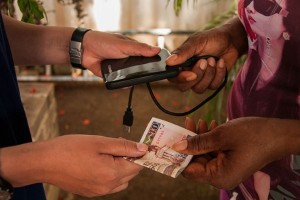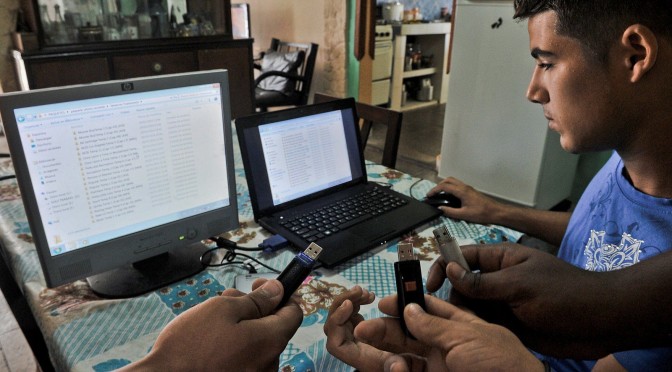By Brian Eggert
Introduction
In the year 2016, the vast majority of Cuba’s population does not have Internet at home. The most popular alternative is a black market of information distributed through USB drives in the form of paquetes semanales or “weekly packages” of homemade Internet. These paquetes, which consist of news, video, music, books, and more, have created a host of new jobs for compilers and distributors. These individuals compete based on the reputation, price, quality, and specialization of their products and set prices based on the supply and demand for specific content. Some middle men travel in person between Havana and the provinces each week, all attempting to establish monopolies on niche categories of current information. The foot soldiers beneath them work on commission, operating from known vending locations or even going door to door with printed lists of their offerings. After reaching a fixed sales-quota assigned by the distributor, they are allowed to keep the remaining profits. The distribution network thus forms a pyramidal structure that strikingly resembles the illegal drug trade, with the top spots held by compilers who have unique access to content, through a combination of technical skill and contacts able to leave the island and smuggle in the content and prerequisite hardware. This illegal practice is common throughout the country and represents a serious new problem for the Cuban government, which must cope with the increasing mobility of digital information and its demand for a citizenry long stifled by censorship.

Analysis
In addition to filling a gap in the market for affordable and accessible content, the paquetes represent a form of cultural resistance to the government’s censorship, which in addition to politically threatening websites includes YouTube, Skype, most Google apps, and nearly all forms of private messaging. While a technical solution to the censorship problem might be the use of VPNs, torrents, and encrypted messaging, such options are beyond the reach of most Cubans, who have relatively low levels of information literacy and use hardware and software considered obsolete by today’s standards. For most Cubans, the illegal consumption of paquetes is the most viable form of protest to conditions they are ill equipped to fight technologically. In this way, their participation in the paquete market could be understood as a form of resistance that Bayat (2000) refers to as “quiet encroachment;” i.e. “small-scale, everyday, tiny activities which the agents could afford to articulate given their political constraints” (Bayat, 2000). The government has attempted to combat this everyday encroachment through the formalization of the information economy, which included release of a free, state-sanctioned paquete called the mochila (“backpack”). However, the mochila has failed to compete with the illegal versions that inspired it because it is seen as a mere extension of the censored and propagandistic content already available through other state media channels. Moreover, inconsistent policing of the distribution of paquetes sends a mixed message to citizens, as does the government’s toleration of the 2015 launch of Netflix, which provides a formally illegal service to Cubans who have access to international payment methods. The government is caught in a paradox, no longer capable of enforcing its totalitarian control of information through censorship efforts like the Black Spring of 2003, but not yet prepared for the consequences of free information in an ideologically captive society.
Implications
The illegality of the paquete is complicated by the conditions of its enforcement, which a Cuban scholar visiting UT-Austin described as “una naturalización de las cosas ilegales—la gente no sabe la ley (a naturalization of illegal things—the people don’t know the law).” Someone caught selling or buying the paquete can receive punishment ranging from a slap on the wrist to prison time. This inconsistency can be understood as an example of Ananya Roy’s concept of informality, where state authority is reproduced through the determination of states of exception (Roy, 2005). Giorgio Agamben originally applied the state of exception to populations lacking territorial and institutional status: building on the Foucauldian concept of biopolitics, he argued that refugees, ghetto dwellers, and other impermanent residents are deprived of citizenship in these contexts of legal uncertainty, leaving the determination of their governance to the often illogical and sometimes violent whims of the sovereign powers (Agamben, 1998). By appropriating the state of exception beyond this specific context, Roy extends the concept to the notion of informality, which is present with varying degrees of visibility in nearly all sovereign-subject relationships. In the case of Cuba’s information economy, with the state allowing the black market to thrive while cherry-picking arrests, the Cuban government is resorting to this very tactic in an attempt to assert its dominance over a population that can never know how far is too far. Nonetheless, this governmental “right to exclude” faces a fearsome opponent in its natural proletarian counterpart, the “right not to be excluded,” which has the advantage of vast and ultimately uncontrollable complexity.
This vast complexity makes the paquete semanal an ideal case for analysis through the framework of ANT and assemblages, originally developed by Deleuze and Guattari, in which human agency is reduced to the same level as nonhuman agency. Political, capitalistic, hedonistic, and revolutionary intentions all become irrelevant when viewed through this lens. The human actors involved are content creators, compilers, sellers, and middle-men both local and long-range, buyers, law enforcement, state policymakers, network infrastructure/service providers, international corporations, and very importantly, international travelers who come and go from the island. The nonhuman actors that complete the assemblage are airplanes, boats, cars, motorcycles, bicycles, shoes, computers, phones, tablets, myriad storage devices, and all manner of wires, cables, towers, and satellites. Compilers constitute perhaps the most important node of this network, for they connect the local actors to all those external to Cuba. While local, the agency of compilers resides in their relationships to travelers, information networks, and computers capable of quickly compiling a terabyte of data. In their discussion of the “new mobilities” paradigm, Sheller & Urry (2006) describe these material actors as an “obligatory range of network tools.” They contend, “The greater the proliferation of such ‘tools’ and hence the greater the networking possible, so the more that access to such tools is obligatory in order to participate fully in a ‘networked society’” (Sheller & Urry, 2006). Thus, through incorporating the nonhuman actors and mobilities both physical and symbolic involved in the circulation of the paquete semanal, it is clear that it cannot be treated as a purely local phenomenon. It is a smooth, fluid assemblage that crosses international boundaries.
In this way, the case of the paquete semanal provides important lessons for critical international planning. First, it represents the possibility that survives in the face of governmental dominance when certain conditions of “liquid modernity” are present. People must collaborate across social boundaries and construct new forms of solidarity based on necessity, a phenomenon that AbduMaliq Simone refers to as “people as infrastructure”. This concept reflects “residents’ needs to generate concrete acts and contexts of social collaboration inscribed with multiple identities rather than in overseeing and enforcing modulated transactions among discrete population groups” (Simone, 2004). Second, this case suggests that planners must embrace some amount of disorder or “disassembly” because, as Pablo Sendra reminds modern assemblage thinkers, “there is no diagram that does not also include, beside the points which it connects up, certain relatively free or unbound points, points of creativity, change, and resistance” (Sendra, 2015). Such disassemblies, which planners tend to resist because they contradict the desire for order, provide the conditions for autonomy, innovation, and new jobs and markets as seen with the paquete in Cuba.
